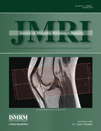Three-dimensional dynamic time-resolved contrast-enhanced MRA using parallel imaging and a variable rate k-space sampling strategy in intracranial arteriovenous malformations
Abstract
Purpose
To evaluate the effectiveness of three-dimensional (3D) dynamic time-resolved contrast-enhanced MRA (TR-CE-MRA) using a combination of a parallel imaging technique (ASSET: array spatial sensitivity encoding technique) and a time-resolved method (TRICKS: time-resolved imaging of contrast kinetics) and to compare it with 3D dynamic TR-CE-MRA using ASSET alone in the assessment of intracranial arteriovenous malformations (AVMs).
Materials and Methods
Twenty consecutive patients with angiographically confirmed AVMs were investigated using both 3D dynamic TR-CE-MRA techniques. Examinations were compared with respect to image quality, spatial resolution, number and type of feeders and drainers, nidus size, presence of early venous filling and temporal resolution. Digital subtraction angiography was used as standard of reference.
Results
The higher temporal and spatial resolution of 3D dynamic TR-CE-MRA TRICKS ASSET allowed a better assessment of intracranial vascular malformations, namely better depiction of feeders, drainers and better detection of early venous drainage. There was no significant difference between them in terms of nidus size.
Conclusion
3D dynamic TR-CE-MRA combining parallel imaging and a time-resolved method with subsecond and submillimeter resolution could become the first-line investigation technique in both diagnosis and follow-up of intracranial AVMs. J. Magn. Reson. Imaging 2009;29:7–12. © 2008 Wiley-Liss, Inc.




